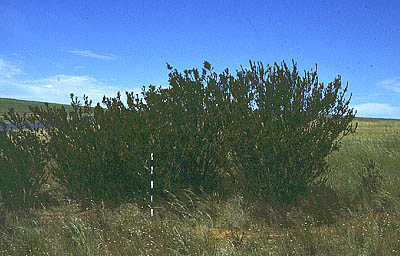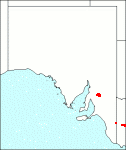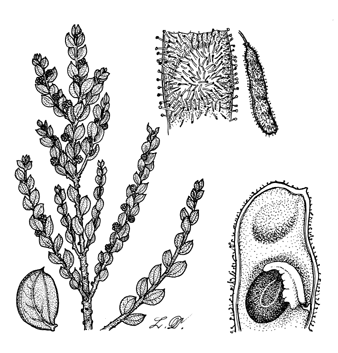Family: Fabaceae
Acacia glandulicarpa

Citation:
F. M. Reader, Vic. Nat. 13:146 (1897).
Derivation: glandula (Latin)--a small gland; karpos (Gr.)--fruit. Synonymy: Not Applicable Common name: Hairy-pod wattle
Description:
Somewhat viscid, rather dense, rounded, spreading, much branched shrubs 1-2 m high with a dull olive-green foliage; branches grey-brown, terete, pubescent, marked with small raised leaf bases along the stems. Phyllodes obliquely oblong-obovate to more or less elliptical, 5-12 mm long, 3-6 mm broad, erect, thick, rigid, glabrous, minutely glandular, sometimes viscid when young, lower edges usually undulate, 2-veined with the central vein more prominent, lateral veins few, obscure, apex shortly mucronate. Inflorescences simple and axillary, solitary or twin; flower-heads bright yellow, 8-20-flowered; peduncles about as long as phyllodes; flowers 5-merous. Legumes narrowly oblong, 1.5-3 cm long, 2-3 mm broad, straight or curved, viscid and covered with glandular shining hairs. Seeds oblique in legume, obovoid-ellipsoid; funicle short, folded under seed and thickening gradually into an elongated aril.
|
|
Distribution:
|
A small population of this species has been discovered in the Northern Lofty region in the Burra Gorge area on rocky hillside in open scrub vegetation. Associated with Eucalyptus socialis and Callitris preissii. Soils; hard alkaline red duplex. Rainfall 400-500 mm. Also Little Desert, western Vic. The first collection in S.A. was by C. D. Boomsma at Burra, as recently as September, 1966.
S.Aust.: NL, MU, SE.
|
Conservation status:
Lang & Kraehenbuehl (1987) consider this species to be Endangered in South Australia, Briggs & Leigh (1988) consider it Vulnerable but with populations conserved for Australia. Flowering time: July — October. |

SA Distribution Map based
on current data relating to
specimens held in the
State Herbarium of South Australia
|
Biology:
No text
Related taxa:
Acacia acinacea is similar in phyllode shape but differs in its single main vein and spirally coiled more or less glabrous legumes. Acacia paradoxa has a similar habit but differs in the 1-veined phyllodes and spiny stipules.
Taxonomic notes:
Stuwe (1982) discusses the range and abundance of this very limited species in western Victoria where the main occurrence is between Nhill and Dimboola.Until recently A. glandulicarpa was known only from a few plants in the Burra Gorge. Scattered colonies ranging from 2 plants to several hundred have now been found in areas a little north-west of Hanson. Native woody vegetation has been almost completely removed in this area and there are virtually no trees except scattered A. pycnantha, some colonies of A. paradoxa and rare colonies of A. glandulicarpa. It is probable that the species is sparingly clonal and has been able to survive by this means. All colonies were confined to roadsides. Acacia glandulicarpa is described as useful ground cover and as tolerant of frost in Canberra, Anon (1974).
Cultivation:
A small compact shrub; would be suitable for ornamental planting. Moderate growth rate.
Author:
Not yet available
Source:

|

